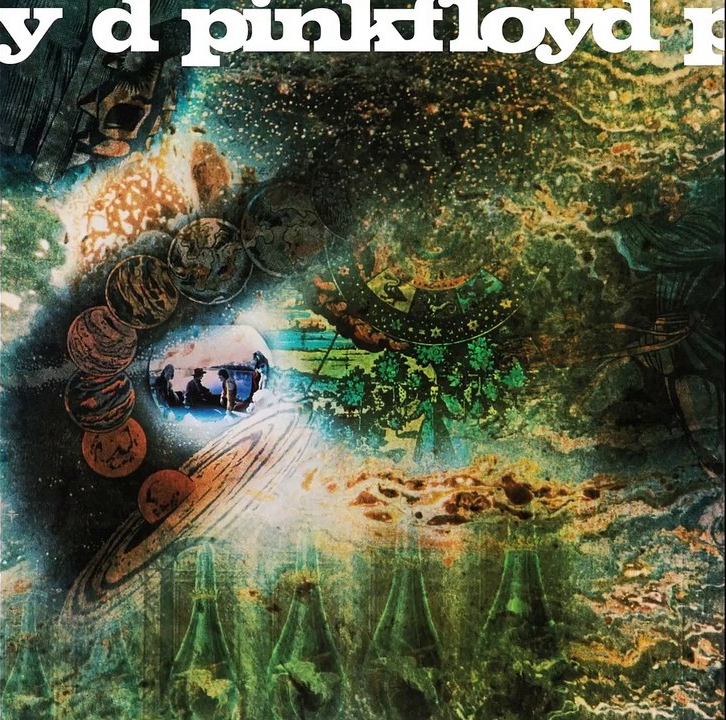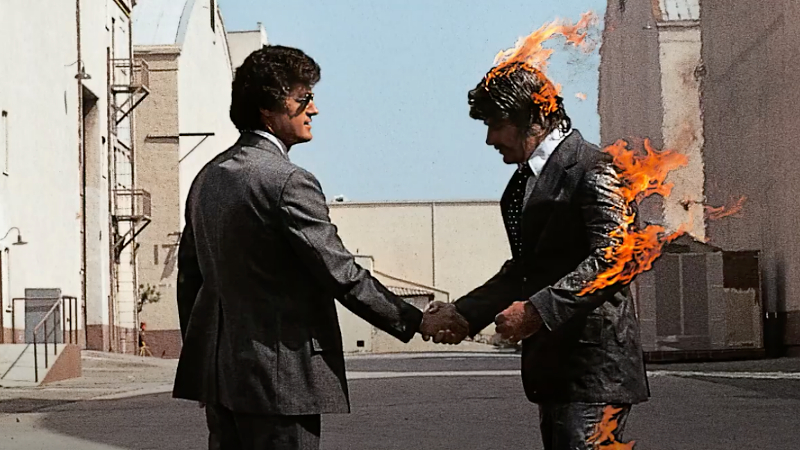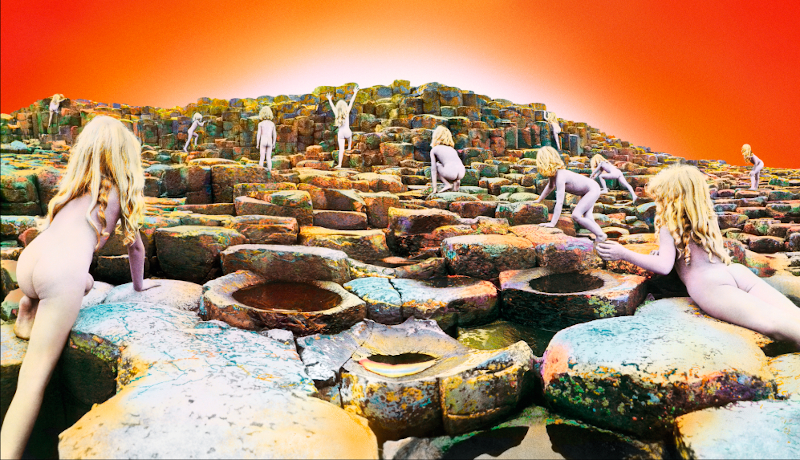Director – Anton Corbijn – 2022 – UK – Cert. – 101m
*****
The story of the visual creatives behind album sleeves, for Pink Floyd and others, who revolutionised the field from the late 1960s and through the 1970s – now out on Blu-ray/DVD combo and various streaming services plus BFI Player following its release in cinemas in the UK and Ireland on Friday, July 14th
Everyone who bought LP records from the late 1960s through to the very end of the 1970s knows the name Hipgnosis. As one interviewee points out, you would go in to the centre of your town to buy the latest album and mull over all the written information on the sleeve on the bus coming home to find out who played on it and who was responsible for the cover. Many of the most memorable sleeves were designed by Hipgnosis, the name coming from ‘hip’, meaning ‘cool’, and ‘gnosis’ meaning ‘secret wisdom’.
Director Corbijn made his name in black and white photography and album sleeves for such bands as U2 and Depeche Mode in the 1980s, so has a background in the album cover world in a later decade. He is therefore extremely well placed to tackle the subject and chooses to film many of his interviewees in trademark black and white. Chief among these is Aubrey ‘Po’ Powell, who along with the late Storm Thorgerson founded Hipgnosis. Other interviewees include clients Gilmour, Mason and Waters of Pink Floyd, Page and Plant of Led Zeppelin, former Beatle Paul McCartney, Graham Gouldman of 10cc, and Peter Gabriel, as well as Noel Gallagher and such legends as photographer Jill Furmanovsky, artist Humphrey Ocean and artist Roger Dean (the latter was part of the competition, favouring illustration- rather than photography-based design, notably for Yes).
Powell first encountered Thorgerson in 1964 in a Cambridge house on the other side of the street from where he was then living frequented by various young people where Storm was a person full of himself, constantly talking. Also at the house were Syd Barrett and others who would later form the band Pink Floyd. Drug use was common. Storm and Po bonded following a police drugs raid on the premises in which they elected to stay behind while everyone else present got themselves (and all the drugs) out. The police could find no drugs so no charges were made. When Storm asked Po why he stayed, the latter replied that he didn’t believe in abandoning things. After that, they were inseparable.

On one occasion, Po approached his room door behind which Barrett could be heard. On the door was scrawled the word hipgnosis. He remembers thinking he’d have to paint over it. The word was later to achieve currency as the name of Storm and Po’s design company. It has often been credited to Syd, but interviewees here attribute it to fellow occupant Adrian Haggard.
They duo didn’t set out to make a career out of art, photography and sleeve design. Storm secured a place studying photography at the Royal College Of Art, and in typically anti-establishment style told Po to come with him and register there as a student. Po very quickly had an epiphany as he fell in love with capturing images with the camera then manipulating them in the darkroom, suddenly knowing that this was what he wanted to do with his life.
After a period in the South Kensington flat at Legerton Court in which Roman Polanski had previously shot Repulsion (1963), and a period where Storm and Po consumed rather more LSD than was wise and ended up in lengthy conversations with psychiatrists trying to extract themselves from its influence, they found themselves in 6 Denmark Street just south of London’s Tottenham Court Road, a building famed for its lack of a lavatory (“everyone used the sink”, says Jill Furmanovsky). The owner left a piano which the new incumbents sold for a tidy sum which enabled them to buy their first photographic cameras and equipment.

Hipgnosis’ first commission, via David Gilmour, was putting together the sleeve for the second Floyd album A Saucerful Of Secrets, for which they manipulated images into a space rock type image of vast worlds and galaxies, with a little picture of the band included in a small circle at the insistence of the record company.

As the relationship between the band and the two visual creatives developed, Storm had the idea of putting the most boring image he could find – a cow – on the cover, and Po shot the first one he could find driving out to the country. The band heartily agreed to the idea of no lettering, just the photo. Ironically, this throwaway design for Atom Heart Mother subsequently achieved an iconic status quite the opposite of everyone’s original intention.

Po relates that for The Dark Side Of The Moon, the Floyd’s late keyboard player Rick Wright asked for “not another of your images”. When Storm showed several ideas attempting to be different, the sketch of light refracted by a prism was the one that instantly won over all the band members, and that was that. Hipgnosis would go on to do both Wish You Were Here (a man getting burned in a music business deal, for which the shoot involved 15 takes of a stuntman on fire) and Animals (a giant pig flying above Battersea Power Station).

They had many other musician / band clients. For The Nice’s album Elegy, they shot numerous inflatable red balls in a desert. These had to be deflated for transporting to the location and inflated on arrival, which proved a daunting task not least because of the numbers requiring inflation and the amount of blowing it took. This commission led to work with keyboard player Keith Emerson’s later band Emerson, Lake and Palmer.

The duo also worked for Led Zeppelin, which meant getting the approval of their fearsome manager Peter Grant. For Houses Of The Holy, the shoot for the image of children climbing over Ireland’s Giant’s Causeway didn’t go as planned, and ended up a collage of shots joined at lines cut along hexagonal rock edges with each separate shot using the same two child models, the black and white image being hand-coloured afterwards. For Presence, they came up with a foot high statue inspired by the monolith in 2001 that was meant to encapsulate the ‘presence’ of the band. Some eight physical models were made of the object, and each band member got one.
They also worked with 10cc, including on The Original Soundtrack, worked in beautifully pencilled artwork by Humphrey Ocean from Po’s studies of an editor’s film cutting room. They were also responsible to Peter Gabriel’s first solo albums, all called Peter Gabriel and coming at a time when he was rebranding himself and putting some distance between his persona and that of the band with whom he made his name, Genesis, For the first of these, they had Peter Christopherson, later a musician with bands Throbbing Gristle and Coil, follow Gabriel around New York with a camera to get the images. Christopherson had quite a dark visual sensibility, in marked contrast to Thorgersen and Powell’s brighter, often primary coloured, approach.

Another client was Paul McCartney, who came up with his own ideas, something ideas man Thorgersen found difficult, at one point saying, “Po can do this one on his own.” They did the star-studded prison break for Band On The Run, the two billiard balls for Venus And Mars and taking an expensive artefact McCartney bought in a Christie’s auction up a mountain for Wings’ Greatest, which effect could probably have been just as effectively achieved with a well chosen item from a charity shop and a small studio shoot at a fraction of the cost.
These were the times of ridiculously wealthy rock stars, and in their creative work Hipgnosis too splashed the money around, not always wisely. By then, it was becoming apparent that rock stars with their profligate lifestyle were falling out of touch with the youth of the day, and Hipgnosis decided to knock it on the head. Storm had no idea about money and as they moved into the burgeoning music video business, they vastly overspent and ultimately fell foul of the bank.
The documentary majors on the Floyd (arguably Hipgnosis’ most significant client) and inevitably omits numerous, less well known covers they designed (and the musicians and bands for whom they designed them) to focus in considerable detail on a number of the most iconic ones. As such, it gives their work a good crack of the whip and provides essential viewing for anyone who bought albums in the late 1960s and through the 1970s. For millennials and today’s teenagers, it provides a fascinating glimpse into the visual design area of the music business in the heyday of the LP.
Squaring The Circle: The Story Of Hipgnosis is now out on Blu-ray/DVD combo and various streaming services plus BFI Player following its release in cinemas in the UK and Ireland on Friday, July 14th.
Trailer:
